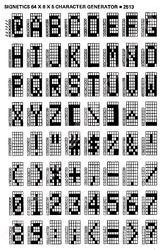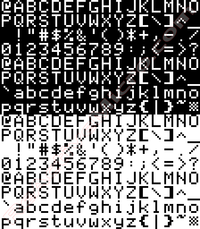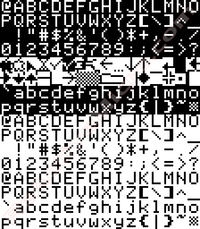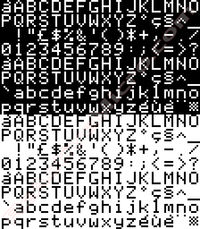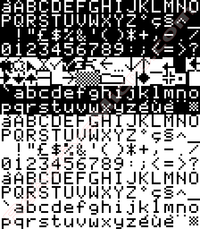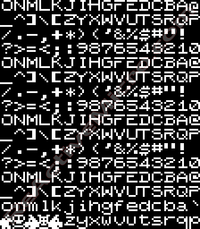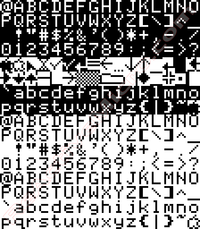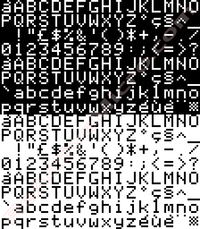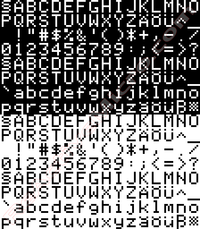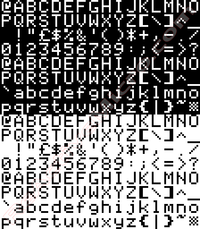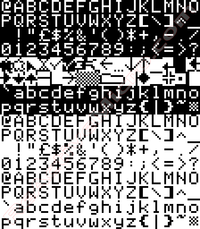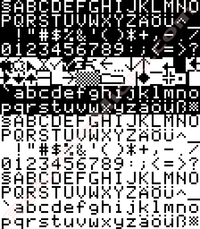Apple IIe Enhancement Kit: Difference between revisions
No edit summary |
No edit summary |
||
| Line 12: | Line 12: | ||
'''Note:''' Some ROMs do not have the "-A" suffix on them. Apple was very inconsistent with their markings. It's also possible this suffix could denote batch or different manufacture runs produced by Apple. | '''Note:''' Some ROMs do not have the "-A" suffix on them. Apple was very inconsistent with their markings. It's also possible this suffix could denote batch or different manufacture runs produced by Apple. | ||
Only older Apple IIe systems require the Enhancement Kit if you wish to run the newer software or use MouseText. Newer system like the Platinum IIe do not require the Enhancement Kit as they would already be Enhancement. Both systems can be easily identified by the user. If your CPU has '65C02' or '65C03' printed on it and the Part Numbers of your ROMs match the numbers listed above, then there is a good chance your IIe is already Enhanced and you don't need this Kit. Another good test is to perform a Self Test (Control, Closed-Apple, and Reset). An Enhanced IIe displays colored low-res squares on the screen intermittently. An Unenhanced IIe displays animated white and black horizontal bars. | Only older Apple IIe systems require the Enhancement Kit if you wish to run the newer software or use MouseText. Newer system like the Platinum IIe do not require the Enhancement Kit as they would already be Enhancement. Both systems can be easily identified by the user. If your CPU has '65C02' or '65C03' printed on it and the Part Numbers of your ROMs match the numbers listed above, then there is a good chance your IIe is already Enhanced and you don't need this Kit. Another good test is to perform a Self Test (Control, Closed-Apple, and Reset). An Enhanced IIe displays colored low-res squares on the screen intermittently. An Unenhanced IIe displays animated white and black horizontal bars. See the [[#Testing If Your System Is Or Is Not Enhanced|Testing If Your System Is Or Is Not Enhanced]] section below for more information. | ||
| Line 40: | Line 40: | ||
'''Note:''' There is a MouseText difference in the older II Enhanced character sets verses the newer IIgs character set. The "F" and the "G" Mousetext characters are different. On the other II systems they are used to make a "running man" character. On the IIgs they are used for for menu system icon characters. This caused a minor visual issue with some software and BBSes from the era that used MouseTest. | '''Note:''' There is a MouseText difference in the older II Enhanced character sets verses the newer IIgs character set. The "F" and the "G" Mousetext characters are different. On the other II systems they are used to make a "running man" character. On the IIgs they are used for for menu system icon characters. This caused a minor visual issue with some software and BBSes from the era that used MouseTest. | ||
== Testing If Your System Is Or Is Not Enhanced == | |||
If your CPU has '65C02' or '65C03' printed on it and the Part Numbers of your ROMs match the numbers listed above, then there is a good chance your IIe is already Enhanced and you don't need this Kit. However this is only is only a visual check for the CPU. There is a chance your CPU could be "fake" which mean it could be a 6502 and have had the original part number removed and a new printed on it. This has become an increasing issue in the Retro Community as parts become more scarce. To be certain an OpCode check should be performed using a test program. | |||
Another good way to tell if your system is enhanced is to perform a Self Test (Control, Closed-Apple (Option key), and Reset). An Enhanced IIe displays colored low-res squares on the screen intermittently. An Unenhanced IIe displays animated white and black horizontal bars. However this only checks if the ROMs are the enhanced versions and does not test the CPU for being a C02. | |||
Here is a BASIC program which you can enter that will check and identify which CPU you actually have installed. This is the only way to fully check for a C02 CPU installed. | |||
6000 REM IDENTIFY THE PROCESSOR | |||
6010 I = 800 | |||
6020 READ J: IF J < 0 THEN GOTO 6040 | |||
6030 POKE I,J: I = I + 1: GOTO 6020 | |||
6040 CALL 800 | |||
6050 CPU = PEEK(0): REM 0 = 6502, 1 = 65C02, 2 = R65C02, 3 = 65802/816 | |||
6060 RETURN | |||
6070 DATA 160,0,248,169,153,24,105,1,216,48,21,160,3,162,0,187,208,14 | |||
6080 DATA 166,234,136,132,234,23,234,196,234,134,234,208,1,136,132,0 | |||
6090 DATA 96,-1 | |||
Save and RUN. | |||
Credit: David Empson (https://groups.google.com/forum/#!topic/comp.sys.apple2/y4x1OsPaaI8). | |||
Revision as of 18:47, 29 September 2017
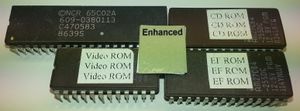
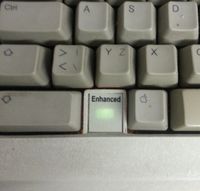
The Apple IIe Enhancement Kit by ReActiveMicro is a reproduction of "The Apple IIe Enhancement Kit", Apple Part Number(PN): A2M2052. It allows the older Apple IIe systems to run the newer 65C02 software, and display MouseText.
The Kit is composed of 5 items:
- 65C02 CPU, 40 Pin DIP
- "CD" ROM, 28 Pin DIP, 27C64 Series ROM, Apple PN: 342-0304-A
- "EF" ROM, 28 Pin DIP, 27C64 Series ROM, Apple PN: 342-0303-A
- "Video" ROM, 24 Pin, 27C32 Series ROM, USA Text Version, Apple PN: 342-0265-A
- "Enhanced Sticker"
Note: Some ROMs do not have the "-A" suffix on them. Apple was very inconsistent with their markings. It's also possible this suffix could denote batch or different manufacture runs produced by Apple.
Only older Apple IIe systems require the Enhancement Kit if you wish to run the newer software or use MouseText. Newer system like the Platinum IIe do not require the Enhancement Kit as they would already be Enhancement. Both systems can be easily identified by the user. If your CPU has '65C02' or '65C03' printed on it and the Part Numbers of your ROMs match the numbers listed above, then there is a good chance your IIe is already Enhanced and you don't need this Kit. Another good test is to perform a Self Test (Control, Closed-Apple, and Reset). An Enhanced IIe displays colored low-res squares on the screen intermittently. An Unenhanced IIe displays animated white and black horizontal bars. See the Testing If Your System Is Or Is Not Enhanced section below for more information.
Project Status: Complete. In production. Actively sold by ReActiveMicro.
Support: Post on the Discussion page (link above) or email ReActiveMicro Support.
Sales: Visit the ReActiveMicro Store.
History
When Henry from ReActiveMicro first returned to the Apple II he found several systems obtained were Unenhanced. This cased several issues with testing and projects. After a little research Henry found that upgrade the IIe was quite simple, and created The Apple IIe Enhancement Kit for sale to the Apple II Community.
Later in 2015 Henry created the "Enhanced Sticker" for the Kit after several people had inquired about it. This sticker is a very close recreation to the original offered by Apple.
Major Benefits of the Enhancement Kit
The Enhancement Kit has four major benefits:
- Apple IIc compatibility: Users can take advantage of newer software developed for the Apple IIc.
- Product line consistency: Apple II software can be used interchangeably on both the Apple IIe and IIc.
- The MouseText character set makes it easy for developers to create software that uses pull-down menus, windows, and icons.
- Easier programming for users:
- Accepts BASIC commands in both upper and lowercase.
- Additional instructions in the 65C02 (OP Codes).
- Mini-assembler for machine language programs.
Note: There is a MouseText difference in the older II Enhanced character sets verses the newer IIgs character set. The "F" and the "G" Mousetext characters are different. On the other II systems they are used to make a "running man" character. On the IIgs they are used for for menu system icon characters. This caused a minor visual issue with some software and BBSes from the era that used MouseTest.
Testing If Your System Is Or Is Not Enhanced
If your CPU has '65C02' or '65C03' printed on it and the Part Numbers of your ROMs match the numbers listed above, then there is a good chance your IIe is already Enhanced and you don't need this Kit. However this is only is only a visual check for the CPU. There is a chance your CPU could be "fake" which mean it could be a 6502 and have had the original part number removed and a new printed on it. This has become an increasing issue in the Retro Community as parts become more scarce. To be certain an OpCode check should be performed using a test program.
Another good way to tell if your system is enhanced is to perform a Self Test (Control, Closed-Apple (Option key), and Reset). An Enhanced IIe displays colored low-res squares on the screen intermittently. An Unenhanced IIe displays animated white and black horizontal bars. However this only checks if the ROMs are the enhanced versions and does not test the CPU for being a C02.
Here is a BASIC program which you can enter that will check and identify which CPU you actually have installed. This is the only way to fully check for a C02 CPU installed. 6000 REM IDENTIFY THE PROCESSOR 6010 I = 800 6020 READ J: IF J < 0 THEN GOTO 6040 6030 POKE I,J: I = I + 1: GOTO 6020 6040 CALL 800 6050 CPU = PEEK(0): REM 0 = 6502, 1 = 65C02, 2 = R65C02, 3 = 65802/816 6060 RETURN 6070 DATA 160,0,248,169,153,24,105,1,216,48,21,160,3,162,0,187,208,14 6080 DATA 166,234,136,132,234,23,234,196,234,134,234,208,1,136,132,0 6090 DATA 96,-1
Save and RUN. Credit: David Empson (https://groups.google.com/forum/#!topic/comp.sys.apple2/y4x1OsPaaI8).
Video ROMs
Several Video ROM options were offered by Apple to fit their markets. "USA" English however was the most common. The early Apple II and II+ did not use a PROM, but a 2513 Character ROM widely used in a lot of ASCII terminals from the era. 27-series PROM support which allowed for a custom character set and lowercase wasn't until later "Rev. 7" motherboards.
- American Video ROM Options:
-
2513 Character ROM
Pre-Rev. 7 II/+ Motherboards
24 Pin
Some users also created their own Video ROMs.
- Custom Video ROM Options:
The ReActiveText character set more closely resembles that of an IBM 286 PC clone computer with AMI BIOS, and has an Apple cursor instead of a "grid" character. Henry created this custom ROM back in 1989. An avid BBSer, he was frustrated that there was a difference in MouseText character sets between the Apple IIe and IIgs. Most of the MouseText BBSes were written for the IIgs and didn't "look" right on the IIe. Henry, sensing an opportunity to help the Apple II Community, set out to edit and "fix" the IIe's MouseText character set. Once completed, he also edited the letter characters to be more pleasing to the eye. The Apple IIe and IIc has never looked so good!
The PigFont ROM: Quote from Kevin Lightner - "The ROM was originally developed for a BBS called the Pig Sty. It was a very private board inhabited by some of the top crackers and pirates of the day (early to mid 1980's). The Pig Sty was headed by Mort Goodman in Orange California and was limited to something like 30 members. Mort was a book binder by trade, but a pirate by hobby. He'd not only copy the disks, he'd copy the manuals, bind them, etc. The Pig Font was made by one of the members (The Freeze) if I recall, as a gift for Mort. There were also various knockoffs of the original PigFont."
Note: The PigFont ROM is displayed backwards. This is because the II+ is not "reversed" like the IIe/IIc is and the program used to make the character images always reverses for Apple II mode.
- Euro Video ROM Options:
Note: The Euro ROMs are a larger size and contain two character sets. This is due to a "switch" option on the Euro IIe. Under the keyboard end of the case is a small switch that allows the user to select between the two character set in the ROM.
For convenience we have created IIe versions (2732 ROM) of the ROMs listed above. This will allow the use of the Euro ROM in a IIe/IIc/IIc+, however the ROM is not "switchable" as it is in a Euro IIe. Once installed it will be that character set until the ROM is physically removed and changed for something else. See the "Single" folder under the "Dual-Euro" ROM folder.
- We created IIe/IIc versions of the Euro ROMs which can be found on our Server:
-
ReActiveMicro Downloads
We also sell custom Euro ROMs with any combination of the above images, or ones you send us.
You can make or edit your own ROMs using Omnivore by Rob McMullen. Big thanks to Rob for his help in making this page possible!
